Farmcircle
Product Name
Farmcircle
Type
Mobile App
Year
2025
Tools used
Figma, Notion, Survey Planet
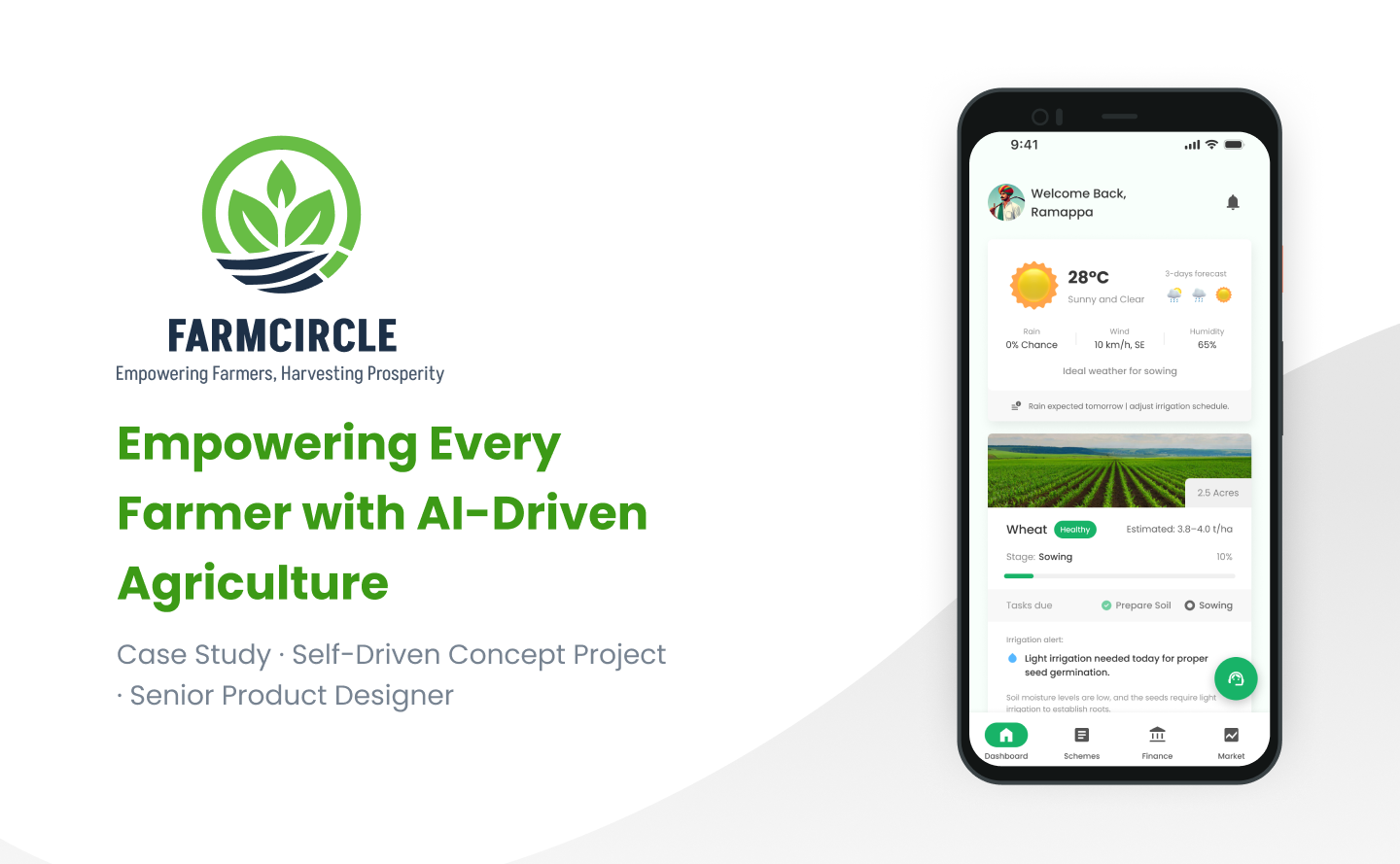
Product Name
Farmcircle
Type
Mobile App
Year
2025
Tools used
Figma, Notion, Survey Planet

Farmcircle FarmCircle — a research-driven agri-tech companion for Indian farmers, validated with field users
In India, smallholder farmers face chronic yield losses from pests and disease, realize only a fraction of the consumer price, and struggle to access formal credit and government welfare. FarmCircle is a mobile-first, voice-enabled platform that helps farmers move from guesswork to confident, insight-driven decisions—across crop planning, daily farm tasks, pest diagnostics, price discovery, market access, and agri-finance. Farmers increasingly own smartphones, yet many have low digital literacy and patchy connectivity; FarmCircle is designed to work offline-first with local-language voice so semi-literate users can succeed.
This project was conceived and executed as a portfolio case study and tested in the field: a high-fidelity prototype was evaluated with 15 farmers in Karnataka (mixed literacy and tech familiarity). We collected task-success metrics, behavioral insights, and verbatim quotes to validate the core experience before proposing the product roadmap.


(Research, UX, UI, Prototyping, Testing)






Duration

Prototype tested in

Indian farmers face structural constraints that suppress yield, income, and adoption of digital solutions. Evidence from secondary research and field interviews highlights five core problem areas:
| Problem | Research Signal | Farmer Voice |
|---|---|---|
| Unscientific crop decisions & preventable yield loss | Pests/diseases contribute to ~20–33% yield loss. | “I’m never sure when to spray—sometimes it’s too late.” |
| Value leakage in the supply chain | Farmers often receive only ~33% of the final retail price for TOP crops (tomato, onion, potato). | “I sell to the local agent; I don’t know if it’s a good deal.” |
| Credit exclusion and cost of capital | ~50% of farmers lack access to traditional financing; those who borrow often pay 10–25% above market rates. | “Bank loans are hard; I pay 3% per month to the input dealer.” |
| Low awareness / high friction for government schemes | Registration on eNAM has scaled, yet awareness/last-mile access to schemes remains uneven. | “I waited hours at the office and was told to come another day.” |
| Language & connectivity barriers | Rural smartphone ownership surged to 74.8% of households (2018→2022), yet internet use and digital literacy still lag. | “If the app speaks Kannada and shows pictures, I can follow.” |
Design implication: Farmers need a localized, voice-first, offline-capable assistant that turns complex data (weather, prices, finance, schemes) into simple, daily, stage-wise actions.

FarmCircle aims to be the intelligent, inclusive companion for Indian farmers:

These personas were synthesized from 20 interviews across three states and validated during prototype tests:
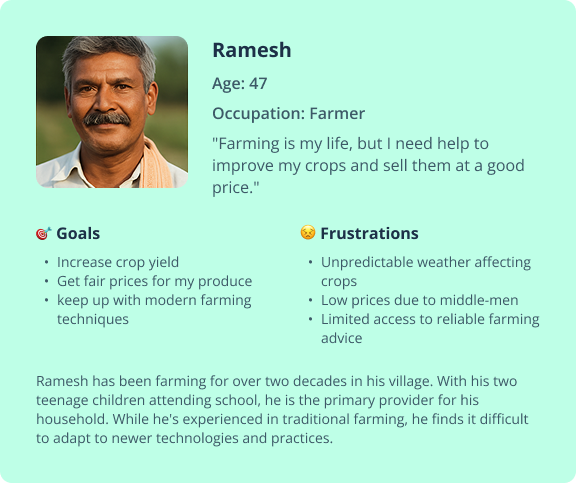
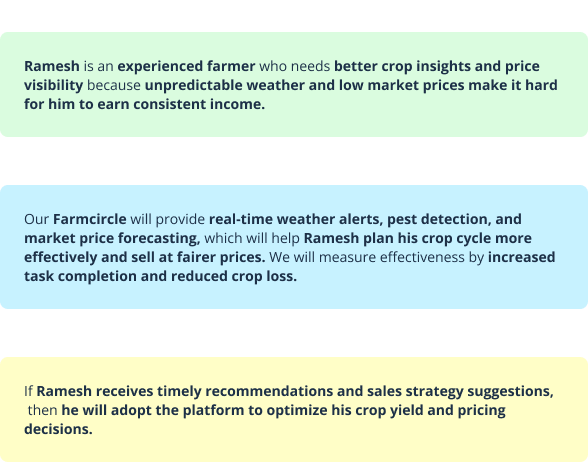
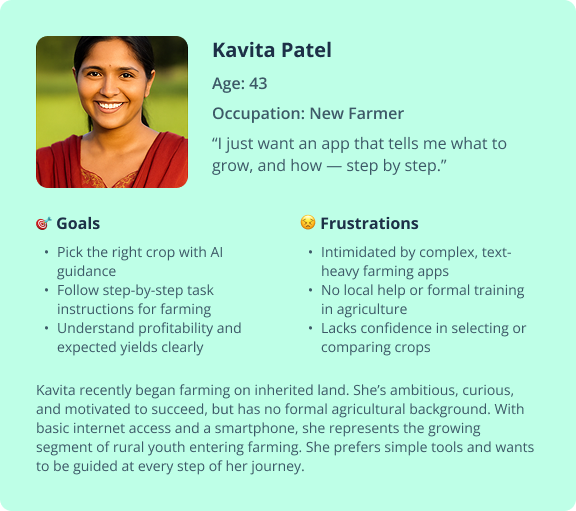
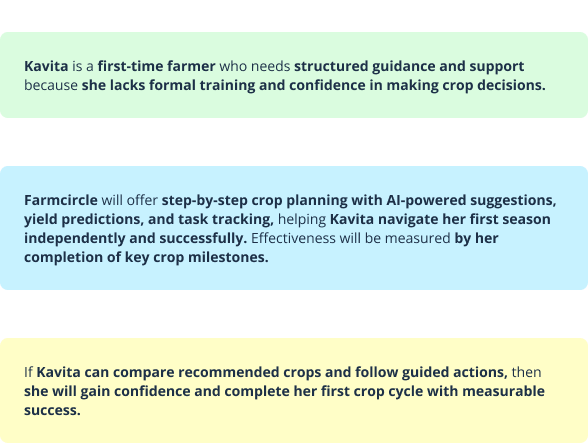

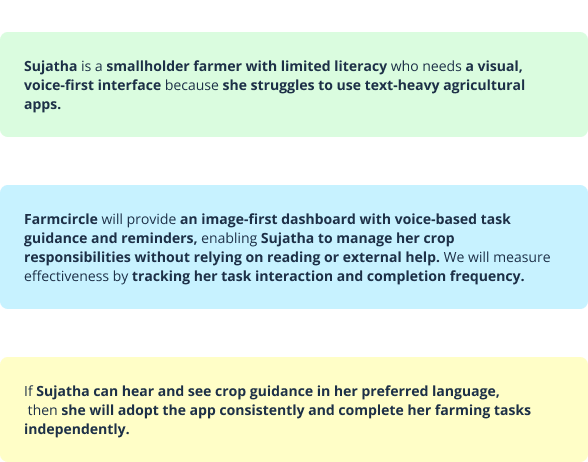



| Stage | Tasks | Emotions | Pain Points | Opportunities |
|---|---|---|---|---|
| 1. Start of the Season | Picks crop based on tradition, talks to middlemen or neighbors | Confused, unsure | Relies on outdated techniques, no forecast data | Offer AI-based crop suggestions based on land and market |
| 2. Prepping the Land | Arranges fertilizer, seeds, equipment | Determined but anxious | Doesn’t know optimal inputs or when to use them | Provide personalized schedule and tips based on crop stage |
| 3. During Crop Growth | Irrigates, applies fertilizer | Stressed by weather, hopeful | Unpredictable rain, unsure of timing | Send weather-based alerts and reminders with visuals |
| 4. Harvest Time | Hires help, gets bags ready, asks middlemen for pricing | Frustrated, tired | Gets low price from middlemen | Enable market price tracking and direct buyer connections |
| 5. Post-Harvest | Clears fields, pays bills | Relieved, planning next season | Doesn’t analyze past success/failure | Summarize season insights with graphs and earnings report |
| Stage | Tasks | Emotions | Pain Points | Opportunities |
|---|---|---|---|---|
| 1. Entry into Farming | Registers land, chooses crop | Nervous, excited | Unsure which crop is profitable | Guide her with AI crop suggestions and profitability filters |
| 2. Learning the Basics | Reads blogs, asks others, joins WhatsApp groups | Overwhelmed | Inconsistent advice, no structured steps | Provide in-app crop guides, checklists, comparison tools |
| 3. Managing the Crop | Watering, fertilizing, basic tasks | Curious but unsure | Doesn’t know correct timing/dosage | Show stage-wise tasks and allow completion tracking |
| 4. Health Issues or Pest | Notices pest but unsure what it is | Panicked, unsure | Doesn’t know how to treat it | Enable AI-based image detection and treatment tips |
| 5. Selling the Crop | Finds pricing info, tries to contact mandi | Apprehensive | Pricing terms are unclear | Offer guided selling plans with projections and alerts |
| Stage | Tasks | Emotions | Pain Points | Opportunities |
|---|---|---|---|---|
| 1. Crop Selection | Asks husband/community, guesses best crop | Unsure | Can’t use crop selection apps | Enable voice-based crop suggestions in local language |
| 2. Prepping Tasks | Applies manure, prepares land | Confused | Doesn’t remember all steps or timings | Visual calendar + voice reminder for each stage |
| 3. Managing Growth | Applies water/fertilizer | Concerned | Can’t read instructions | Offer simple pictorial instructions with audio |
| 4. Checking Crop Health | Sees discoloration, unsure what’s wrong | Worried | Doesn’t know what to do | Let her send photo, get audio reply on issue |
| 5. End of Season | Prepares harvest | Tired, satisfied | Doesn’t keep records | Show seasonal summary in audio + picture format |
India’s agri-tech stack spans advisory, input commerce, satellite analytics, social knowledge, and government marketplaces (eNAM). Adoption is rising—1.78 crore farmers registered on eNAM—but most tools either focus on post-harvest or assume high literacy/bandwidth. FarmCircle fills this gap with pre-sowing to post-harvest, voice-first, offline UX for smallholders.
| Competitor | Category | Key Features | Strengths | Limitations |
|---|---|---|---|---|
 |
Direct | Input delivery, AI advisory, market access, credit help | Full-stack agri service, large network, strong investor backing | Lacks task-based guidance and personalized dashboards; not built for low-literacy users |
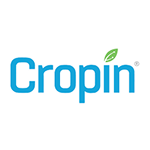 |
Direct (B2B) | Satellite insights, crop health, yield analytics | Enterprise-level analytics, 30–37% yield increase (source: Reuters) | Designed for agri-enterprises; lacks a user-friendly, mobile-first interface for small farmers |
 |
Direct | Crop health via satellite, input advisory, climate info | Affordable, mobile-ready, popular among data-aware farmers | No stage-wise task tracking; lacks regional languages or voice support |
 |
Direct (Social) | Farmer social network, vernacular Q&A, marketplace | Strong community building, peer advice, accessible in multiple Indian languages | No structured crop planning, no AI guidance or in-app tracking |
 |
Direct | Product delivery + agri advice (voice, chat), field demos | Strong presence in input distribution and product-market fit | Push-based sales, not goal-oriented learning or planning |
 |
Indirect | Govt-run mandi network, price discovery, online auctions | Widely adopted, transparent pricing, boosts digital adoption | Doesn’t support pre-harvest activities or crop-specific planning |
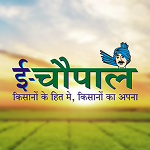 |
Indirect | Local IT kiosks, mandi pricing, weather, agri knowledge | Rural reach via physical infrastructure | Static model; lacks mobile-first, AI, or interactive task flows |
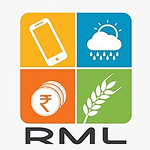 |
Indirect | SMS-based weather, crop, mandi and agri tips | Pioneer in SMS agri info; localized content in multiple languages | Text-based delivery only; lacks interactive or visual-first interfaces |
 |
Indirect | Government apps with scheme info, weather, mandi price | Publicly accessible; some offer audio-based info | Feature-limited; not deeply personalized or proactive |
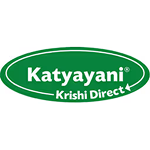 |
Indirect | Input marketplace with expert support and video guides | Visual content, multilingual onboarding, e-commerce for agri inputs | No planning tools, task tracking, or crop insights |
 |
Indirect | Agri warehousing, trading, finance | Key in logistics and storage infra | No support for pre-harvest stages, pest alerts, or crop decision-making |
Differentiation gap-matrix

These features aren't just "functional" they are intentionally crafted to serve real user personas, real use cases, and real constraints in rural India.
| Feature | Description | User Benefit | Why it Matters |
|---|---|---|---|
| AI-Based Crop Planning | Suggests ideal crops based on land data, water availability, and weather forecast. | Helps first-time farmers like Kavita choose profitable crops with confidence. | Reduces trial-and-error and increases yield potential from season one. |
| Task-Based Crop Management | Offers stage-wise task checklists for watering, fertilizing, and crop care. | Farmers like Ramesh can stay organized and proactive throughout the crop cycle. | Drives timely actions and reduces yield loss from skipped activities. |
| Pest & Disease Detection | AI-powered image scanner detects issues through uploaded crop photos. | Farmers can act fast without expert visits, saving time and preventing spread. | Enables early intervention and boosts crop health without needing in-person advice. |
| Visual + Voice Interface | Pictorial dashboard with local-language audio support. | Farmers like Sujatha can follow instructions even without reading text. | Inclusive design opens access for semi-literate and elderly users. |
| Weather-Based Alerts & Irrigation Tips | Real-time weather data triggers crop-specific irrigation and protection tips. | Avoids over/under watering and crop damage from rainfall. | Combines weather tech and agri-science into simple decisions. |
| Market Price Forecasting | Current mandi prices and AI-generated future trends shown for selected crops. | Farmers can choose when and where to sell for better margins. | Empowers smarter sale timing and financial planning. |
| Direct Buyer Access | Enables buyer interest display, chat-based negotiation, and smart sale planning. | Farmers can choose when and where to sell for better margins. | Builds transparency and trust between buyer and grower. |
| Finance & Scheme Explorer | Helps apply for KCC, check subsidy eligibility, and manage bank/KYC data. | Farmers discover financial support they never knew existed. | Solves access barriers in rural finance and boosts adoption of govt schemes. |
| Daily Snapshot Dashboard | Visual summary of weather, active crops, task alerts, market rates, and suggestions. | Gives Ramesh and Kavita a clear view of “what to focus on today.” | Reduces cognitive overload and builds habit of usage. |
| Chat-Based AI Assistant (FarmBuddy) | Farmers can ask questions in natural language (typed or voice). | Sujatha and others get contextual help without navigating menus. | Makes agri-tech feel human, fast, and approachable. |
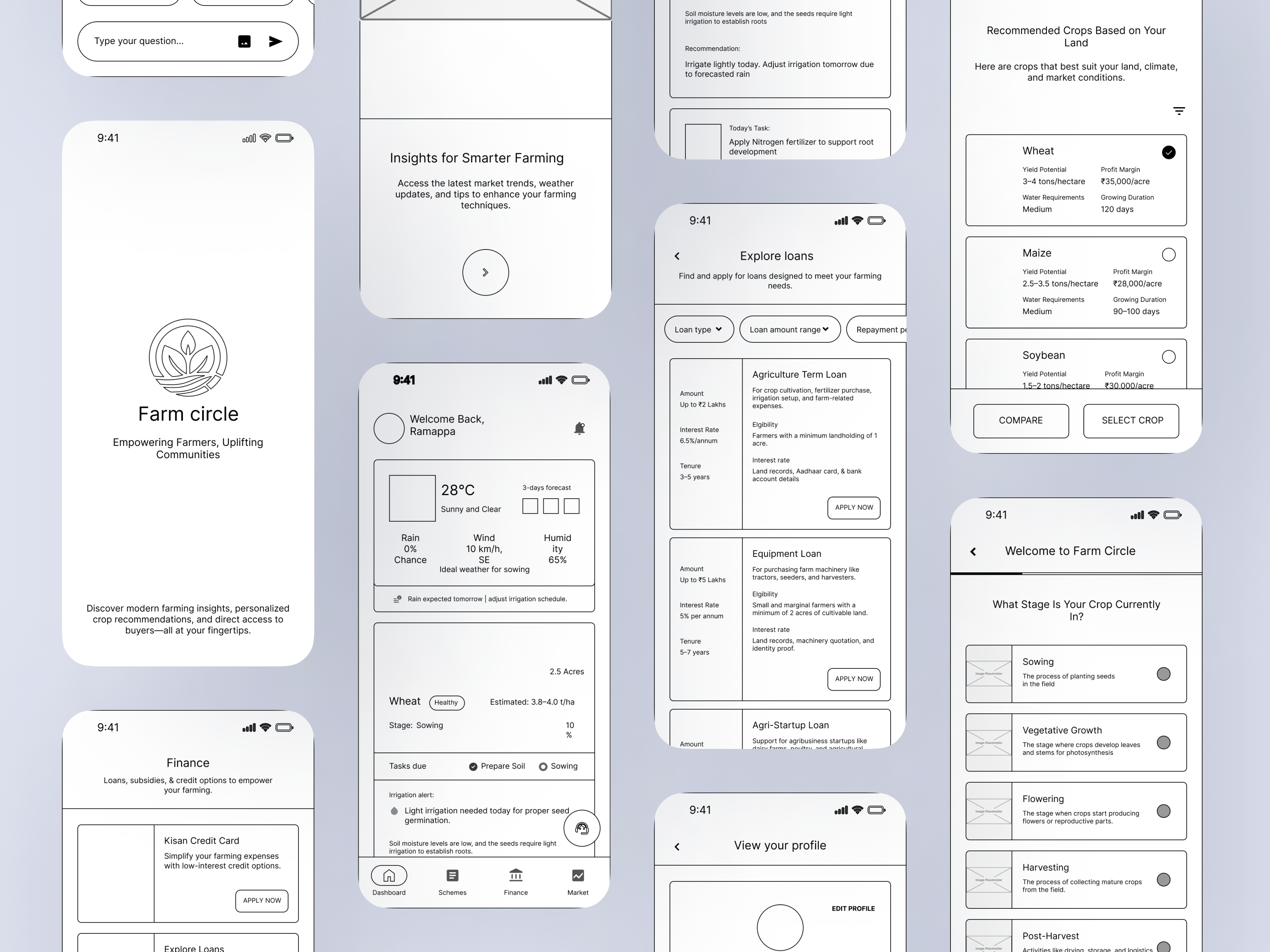


The final high-fidelity click-through prototype can be accessed from here (Click Here)
Based on farmer interviews, we reworked key flows:
We conducted moderated testing with a mix of experienced, new, and semi-literate farmers across Karnataka. All participants interacted with the full FarmCircle flow, from crop selection to market planning, on mobile devices.
| Metric / Feedback Area | Outcome Achieved |
|---|---|
| Task Understanding | 12/15 farmers were able to follow stage-wise tasks without assistance |
| Crop Planning Confidence | 87% reported feeling “more confident” in selecting a profitable crop |
| Adoption Potential | 13/15 expressed willingness to use the app regularly if voice support was available |
| Price Awareness | 10/15 farmers stated that market forecast gave them better control over pricing decisions |
| App Usability for Semi-Literate Users | Sujatha-type users could follow steps with images + voice in prototype walkthroughs |
“This is like a guide I can carry in my pocket.”
“Now I know which crop will give better profit on my land.”
“If the app speaks Kannada and shows pictures, I can do it myself.”
Based on farmer feedback, we added the following to the next phase roadmap:
| Requested by Users | Roadmap Addition |
|---|---|
| Offline mode | App content caching for low-connectivity zones |
| Voice Navigation | Voice navigation for onboarding and core flows (Kannada, Hindi, then Tamil). |
| Video Tutorials | Regional-language crop and finance explainers |
| Manual Chat Support | Layer of live assistance for escalated queries |
| Multi-language onboarding | Added to onboarding sequence and settings |
Farmcircle’s design was not just about adding features, it was about removing friction for users who often feel excluded by agri-tech.
We validated the concept with real users, learned from their behavior, and iterated to make Farmcircle a product that feels familiar yet powerful, especially for India’s underserved farmers.
Most digital products assume literacy, stable internet, and digital familiarity. But for farmers like Sujatha and Kavita, visual, voice-first, and offline-first design is essential not optional.
Farmers responded most positively to “What should I do today?” over dense dashboards. Task-based design outperformed general analytics in both usability and trust.
AI wasn’t just used for automation, it became a teacher, guide, and partner in farming decisions. The AI-driven crop comparison tool gave new farmers like Kavita the confidence to begin.
Testing the prototype with just 15 farmers saved months of assumptions. Even simple observations (e.g., hesitation on a button label) drove meaningful redesigns.
When voice guidance and imagery were added, adoption skyrocketed even among users with no prior app experience.
Farmcircle blends AI with human-centered, region-aware design to make farming less risky and more rewarding. As India’s rural smartphone access accelerates—though literacy and connectivity still vary—solutions must be voice-first, data-driven, and offline-capable. The prototype’s early signals are promising; the next step is a multi-state pilot measuring real outcomes (yield, price realization, credit uptake).